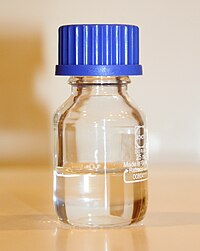
Photo from wikipedia
A cadmium(II) coordination polymer, namely, [Cd2(3-bpcb)(1,2-pda)2(H2O)2] (1), was prepared by hydrothermal reaction of cadmium(II) chloride with 1,2-H2pda (H2pda = 1,2-phenylenediacetic acid) and a bis-pyridyl-bis-amide ligand (3-bpcb = N,N′-bis(3-pyridinecarboxamide)-1,4-benzene). Complex 1 was structurally characterized by… Click to show full abstract
A cadmium(II) coordination polymer, namely, [Cd2(3-bpcb)(1,2-pda)2(H2O)2] (1), was prepared by hydrothermal reaction of cadmium(II) chloride with 1,2-H2pda (H2pda = 1,2-phenylenediacetic acid) and a bis-pyridyl-bis-amide ligand (3-bpcb = N,N′-bis(3-pyridinecarboxamide)-1,4-benzene). Complex 1 was structurally characterized by single crystal X-ray diffraction, which shows a 2D layer structure with (42·6)(42·63·8) topology. Complex 1 was further characterized by elemental analysis, infrared spectroscopy (IR) and thermogravimetric analysis (TGA). The application in removal organic dyes of complex 1 has been investigated.
Journal Title: Journal of Inorganic and Organometallic Polymers and Materials
Year Published: 2017
Link to full text (if available)
Share on Social Media: Sign Up to like & get
recommendations!